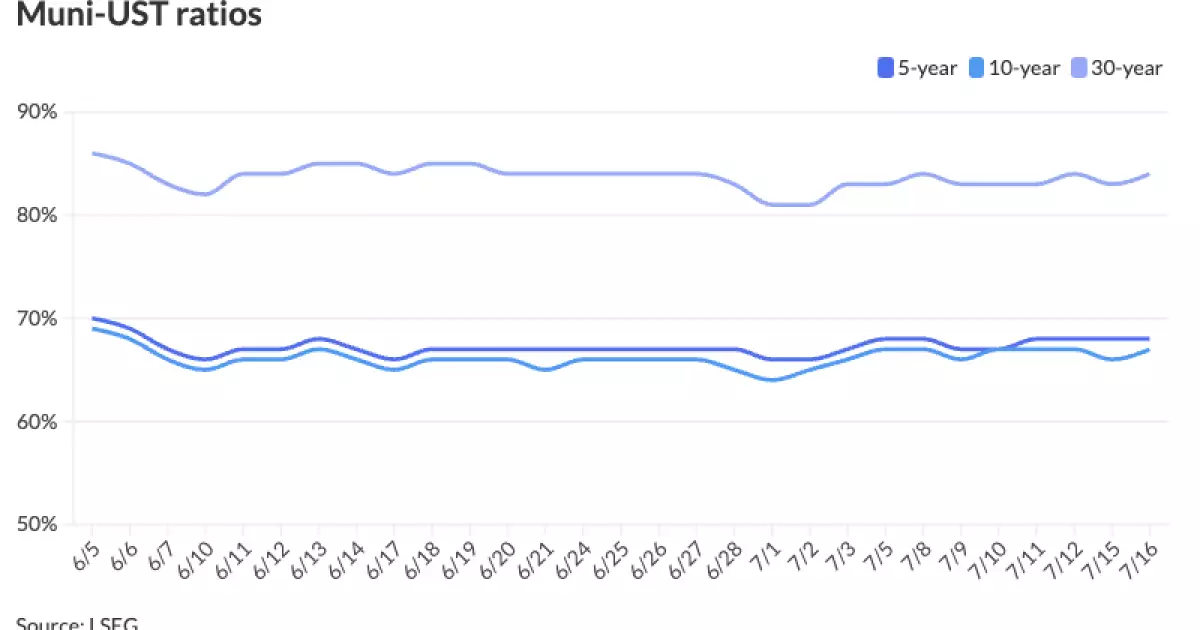The landscape of the municipal bond market is currently experiencing notable shifts that reflect broader economic trends. Recent trading sessions have seen a firming of municipal bonds in secondary markets, coinciding with a modest decline in U.S. Treasury yields. This phenomenon occurs within the context of a recovering equities market, suggesting a synchronization between varying asset classes even amid the complex macroeconomic backdrop. The municipal-to-Treasury yields ratio has provided critical insights, revealing that shorter maturity maturities, such as two-year and three-year bonds, are trading at 65% and 66%, respectively, while the longer maturity 30-year bonds present a slightly different perspective at 84%.
The fluctuations in the municipal bond market can largely be attributed to perceptions of policy changes from the Federal Reserve. According to analysts, including Matt Fabian of Municipal Market Analytics, investor optimism surged following the June consumer price index report, which hinted at potential Federal Reserve rate cuts in the near future. The anticipation of a rate cut has elevated the market’s appetite for bonds with shorter maturities as they are expected to yield the most significant benefits from such monetary policies. However, Fabian warns that these shorter maturities are approaching an “overbought” status, advising investors to exercise caution. In contrast, longer maturities still appear to be “exceptionally oversold,” presenting opportunities for savvy investors seeking to capitalize on potential price recovery.
Interestingly, the municipal bond market is witnessing an influx of retail investor interest. With August projected to bring a substantial tax-exempt reinvestment nearing $40 billion—marking the highest such total anticipated for 2024—investors are encouraged by the reasonable availability of income that municipalities offer. The tumultuous environment has led to a strategic repositioning of capital, particularly in light of nearly 300,000 recorded trades last week. While mutual fund flows showed inconsistency, developments in exchange-traded funds may suggest a strategic approach from investors awaiting favorable market conditions to allocate funds more permanently into tax-exempt securities.
As we look ahead, notable issuance volumes are projected. Analysts estimate that approximately $10.7 billion will flow into the primary municipal bond market this week. A significant portion of this issuance includes various bond types—for instance, Miami-Dade County is set to price $921.86 million in aviation revenue refunding bonds. Noteworthy pricing details also emerge from Georgia’s healthcare sector, where the Northeast Georgia Health System plans to issue $248.1 million in revenue anticipation certificates.
As municipalities express confidence in their financial needs and capabilities, the overall sentiment remains positive for sustained market performance. Notably, diverse issuers such as the San Francisco Public Utilities Commission and the Regents of the University of California are preparing substantial bond offerings, underscoring the breadth and robustness of this market segment.
The performance of AAA-rated bonds has typically provided a bellwether for overall market health. Recent data highlights minor upward adjustments in yields across different scales: Refinitiv MMD’s noted two-basis-point increases in prominent bonds, reflecting a dynamic and responsive market environment. ICE Data Services corroborates this trend, capturing a more comprehensive perspective with illuminating yield curves.
Despite these minor yield adjustments, the overall integrity of the municipal bond market appears resilient. Analysts affirm that heightened issuance should not hinder performance, particularly if positive fund flows can stabilize. Interest from retail investors and consistent buying behavior may counterbalance any market volatility arising from increased supply.
The current trajectory of the municipal bond market indicates a delicate balance influenced by numerous factors, ranging from Federal Reserve policies to regional supply dynamics. As we progress through 2024, it will be essential for investors to remain diligent, particularly when navigating the nuanced landscape of short versus long-term investments.
For investors, the forthcoming months will likely yield both opportunities and challenges. The combination of retail interest, solid municipal offerings, and external economic indicators paints a cautiously optimistic picture for municipal bonds moving forward. Understanding these trends and leveraging them effectively will be crucial for success in this ever-evolving marketplace. Investors will need to keep a keen eye on the economic indicators that shape this intricate web of financial instruments, balancing risk with opportunity as they strategize for the future.

